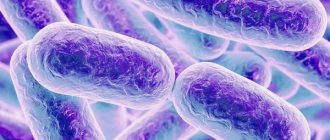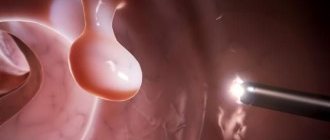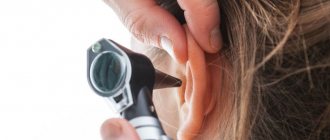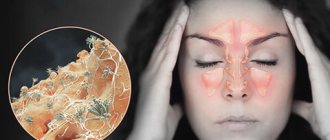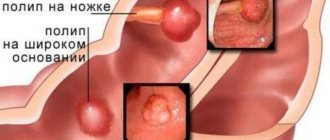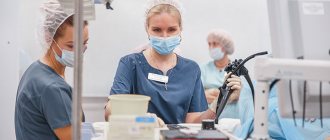Symptoms of nasal polyps
Symptoms indicating the presence of polyps on the nasal mucosa are as follows:
- Breathing through the nose is either difficult or completely impossible. The person experiences a feeling of constant congestion. Such difficulties are due to the fact that the tissues of the mucous membrane have grown and blocked (either completely or partially) the respiratory lumen of the nasal passage;
- When a secondary infection occurs, the mucous glands begin to work harder. For this reason, the patient’s mucus production increases; in advanced cases, it may have purulent impurities;
- The person begins to sneeze more often. This protective reaction of the body is explained by the fact that the polyp irritates the cilia covering the walls of the nasal mucosa. They mistake it for a foreign body and try to clear their nose by sneezing;
- Headache. They are due to a number of factors. Firstly, the body, including the brain, begins to suffer from a lack of oxygen. Secondly, significantly expanded formations put pressure on the nerve endings, causing a natural pain reaction. Thirdly, headache may be caused by an inflammatory process occurring in the paranasal sinuses (in the sphenoid, maxillary, ethmoidal labyrinth or frontal sinus);
- Olfactory function disorders. With significantly expanded polyps, a complete loss of sensitivity to smells may occur. This symptom is due to the fact that overgrown connective tissue disrupts the functioning of the receptors that are responsible for the perception of aromas;
- Large nasal polyps can affect the patient's sense of taste and even cause an unpleasant taste in the mouth;
- In childhood, formations can cause the formation of malocclusion. If a polyp appears in the first year of life, this makes feeding difficult, since the child cannot suck and swallow food normally. As a result, the baby suffers from chronic malnutrition, which leads to weight loss and general malnutrition;
- Change in voice, development of nasality. As a result of the air flow through the nasal passages being disrupted, the patient begins to speak through his nose. In addition, it is known that the nose is the organ that is directly involved in the formation of speech sounds.
The severity of symptoms depends on what stage the growth is at:
- At the first stage, the growth is small, so it only covers the upper nasal septum. The patient experiences slight nasal congestion, which is often perceived as a common ARVI. However, already at the initial stages, the polyp can provoke the development of otitis media, tonsillitis or adenoiditis;
- The second stage of nasal polyposis is characterized by further proliferation of connective tissue. The patient begins to experience difficulty with his sense of smell, his voice changes, and a nasal tone develops. When the formation reaches the auditory tube, speech begins to be distorted and hearing deteriorates. If you do not seek help at this stage, pathological changes may remain forever;
- The third stage is characterized by complete blockage of the nasal passage, the symptoms gain full strength. When an infection occurs, the body temperature rises. In addition, patients suffer from headaches and increased fatigue. The quality of life is significantly reduced by constant nasal discharge.
Causes of nasal polyps
Before turning to the list of reasons leading to the appearance of polyps, you should understand the mechanism of their occurrence. When a virus or bacteria enters the human body, infectious agents multiply. This provokes the detachment of cells in the nasal mucosa. A person begins to suffer from congestion, difficulty breathing, and profuse nasal discharge. If the immune system functions normally and the person receives adequate treatment, then after about a week a complete recovery occurs.
When the process becomes chronic, local immunity malfunctions, and the mucous membrane, in order to increase resistance to the disease, tends to increase the occupied area. The only way to realize this is to begin to grow and become denser. Most often this process occurs in the paranasal sinuses. At some point, there is not enough space for the dividing cells, and they exit into the nasal cavity, and a polyp is formed.
Therefore, specific reasons leading to the proliferation of the nasal mucosa are:
- Infections and colds that are accompanied by a runny nose and occur quite often;
- Chronic inflammation occurring in the paranasal sinuses - frontal sinusitis, ethmoiditis, sinusitis;
- Runny nose of allergic origin (hay fever);
- Diseases such as bronchial asthma, cystic fibrosis, Young's syndrome, Churg-Strauss syndrome, nasal mastocytosis, Kartagener's syndrome, aspirin intolerance;
- Hereditary predisposition to polyposis;
- Too narrow nasal passages, disturbances in the structure of the nasal septum;
- Pathological disruptions in the functioning of the immune defense.
That is, nasal polyps are a polyetiological disease, which is simultaneously influenced by the anatomy of the nose, chronic inflammation of its sinuses and allergies.
Classification and what they look like
There are 2 types of nasal polyps:
- Malignant. They require prompt removal, as there is a risk of further development of the disease. The most dangerous are villous formations that do not have legs.
- Benign. Can remain in the body for a long time.
Most formations are small in size, up to 1 cm. In some cases, symptoms do not appear for several years, so it is difficult to detect the disease. The existence of growths can be recognized if they are large in size, bleed and secrete mucus.
Classification of growths by method of formation:
- Inflammatory. Occurs at the site of inflammation.
- Neoplastic. Formed from atypical cells that have undergone degenerative changes. They can develop into malignant tumors.
- Hyperplastic. Made from healthy cells.
Depending on the form, neoplasms are divided into 2 groups:
- Sitting on a leg. They are attached to the skin using a thin process.
- Sessile with a large base.
Depending on the location of the location, there are:
- Antrochoanal. Location: nasal sinuses.
- Choanal. Formed in the nasopharyngeal tract. More common in children than in adults.
Lack of adequate treatment can lead to the degeneration of tissue growths into malignant ones.
Why are nasal polyps dangerous?
The danger of overgrowth of the nasal mucosa primarily lies in the development of complications. When natural breathing through the nose is not obstructed, the air entering the lungs is humidified and warmed. In addition, dust particles that remain on the mucous membrane are removed from it and then naturally removed. Polyps prevent air from passing freely through the nasal passage, forcing a person to breathe through the mouth.
As a result, the air does not have time to warm up properly, which provokes diseases such as:
- Pneumonia;
- Bronchitis;
- Laryngitis;
- Tracheitis;
- Pharyngitis;
- Laryngotracheitis.
As a result of the disruption of natural communication between the nasal sinuses, the patient suffers from chronic sinusitis.
The larger the growth, the more it puts pressure on the blood vessels of the nasopharyngeal tissue, thereby causing inflammation of the tonsils and the formation of adenoids, enlargement of the palatine tonsils with symptoms of sore throat. Also, poor circulation can lead to the development of chronic tonsillitis. As for disorders of the auditory tube, increased pressure on it leads to the development of otitis or eustachitis.
Possible complications
The appearance of neoplasms gradually reduces the amount of air passing through the nose, the person is forced to breathe through the mouth. The oral mucosa is also part of the immune system. However, as the load increases, the tonsils and other components of the lymphoid peripharyngeal ring begin to suffer, unable to cope with the attack of pathogenic microflora. In addition, chronic inflammation creates favorable conditions for the emergence of atypical cells.
Possible complications of nasal polyposis are:
- frequent bleeding;
- the occurrence of malignant tumors;
- development of infectious processes: tonsillitis, otitis, adenoiditis;
- the appearance of adhesions (subject to chronic inflammation).
Diagnosis of nasal polyp
A doctor can suspect that a patient has a nasal polyp based on his nasal voice, even if the patient himself does not complain of difficulty in nasal breathing. If a polyp forms in childhood, the child’s appearance will tell the doctor about it. In such children, the mouth is constantly open, the lower jaw droops, and the folds of the nasolabial triangle are smoothed out.
To clarify the diagnosis, rhinoscopy is performed, during which the doctor examines the nasal cavities using a special mirror. Polyps appear as fleshy, cluster-shaped or solitary growths.
To assess the stage of their development, a CT scan of the paranasal sinuses is sometimes prescribed. This procedure is mandatory for those patients scheduled for surgery. It is the tomography results that will provide information to the surgeon about the scope of future intervention. If a CT scan is not possible for any reason, the patient should undergo radiography.
In addition to identifying the presence of polyps, concomitant infection should be excluded or confirmed. To do this, a bacterial culture is taken from the nose and pharynx, pharyngoscopy, otoscopy and microlaryngoscopy are performed. Blood sampling for clinical analysis is also necessary. If there is a suspicion of the allergic nature of the growth, then it is advisable to conduct allergy tests.
All diagnostic procedures are prescribed by an otolaryngologist.
Answers to popular questions about nasal polyps
- Do nasal polyps need to be removed? Polyps are scary for their complications, such as sleep apnea, exacerbation of asthma, chronic sinusitis. Surgery is the only way to remove nasal polyps. However, it is worth highlighting such modern methods of removal as laser burning and endoscopic resection with a shaver. As for conservative therapy, it is aimed, first of all, at eliminating the cause of the proliferation of the nasal mucosa. Therapeutic treatment acts as a preparatory stage before surgery;
- Is it possible to heat polyps in the nose? You cannot heat polyps. This is not only an absolutely ineffective procedure, but also to some extent even dangerous, since there is a high risk of burning the mucous membrane. Warming should not be confused with the removal of a polyp thermally using quartz fiber. This procedure is performed by a doctor in a hospital setting;
- Is it possible to treat nasal polyposis without surgery? Treatment without surgery can be aimed at preventing recurrence of polyps, or if there are specific contraindications to surgery. However, it is important to understand that if a polyp has already formed in the nasal cavity, it will not be able to remove itself without surgical intervention.
Prevention
Since in most cases the development of a pathological condition directly depends on the level of immunity, a number of the following measures should be taken to prevent nasal polyps:
- Pay special attention to your general health, avoid hypothermia (especially in the off-season);
- Eliminate foci of infection in the body in a timely manner and prevent their chronicity;
- Follow the principles of a healthy lifestyle: healthy eating, physical activity, adequate sleep, lack of stress;
- Minimize the influence of allergenic factors: wet cleaning, frequent ventilation, natural food, minimum aggressive odors (cosmetics, household chemicals, building materials);
- To prevent colds, use traditional methods of treatment: herbal infusions, inhalations, hot milk, Russian bath, antiseptic plants (onions, garlic, lemon, horseradish, viburnum, etc.), beekeeping products.
The most common folk remedies “to avoid getting sick” are:
- Inhalation of fumes from onions and garlic - they contain a huge amount of phytoncides. Just do this carefully so as not to burn the mucous membrane;
- Rinse your nose daily with saline or sea salt solution. The solution can be purchased at the pharmacy or made yourself: 1 tsp. salt per 200 ml of boiled water. Make sure that there are no particles left in the liquid: filter or leave sediment in the glass. The flushing technique is not complicated, but people with ear diseases should be careful - fluid can get into the middle ear;
- Massage the nose at the points where the trigeminal nerve is located - on the sides of the wings of the nose, do 10 presses with scrolling in both directions.
If you begin to develop nasal polyps, the causes should be sought in the functioning of the immune system. Surgical methods are effective, but even without taking preventive measures and constantly working to improve immunity, they are not able to permanently eliminate the problem.
Treatment of nasal polyps
Conservative therapy for nasal polyposis is intended, first of all, to eliminate those factors that influence the increased proliferation of the mucous membrane. This can be a whole range of procedures offered by modern medicine: laser therapy, injection treatment, therapeutic heating, taking medications.
Only an otolaryngologist surgeon can select the optimal treatment regimen. Sometimes additional consultation with an allergist-immunologist is required.
So, conservative treatment comes down to:
- Eliminating the influence of provoking factors that have a positive effect on the thickening and growth of the mucous layer. It is important to avoid contact with all kinds of allergens (household, pollen, medicinal, professional);
- Elimination of all infectious and inflammatory processes in the nasopharynx;
- Following a diet excluding allergenic foods, as well as spicy and salty foods. Coffee and alcohol are prohibited. It is highly advisable to avoid taking NSAIDs, as well as foods containing preservatives, dyes, and salicylates;
- Regular rinsing of the nasal cavity using saline solutions, for example, Dolphin, Aqua-Maris, Marimer, Gudvada, Physiomer, Doctor Theiss Allergol, Otrivin-More;
- Special gymnastics to restore nasal breathing according to Strelnikova, according to the Buteyko method, self-massage of the ternary nerve;
- Antiallergic and immune drug correction.
Another way to treat polyps without surgery is thermal treatment, when the formations are heated using a quartz fiber inserted into the nose. The temperature reaches 70 °C, which leads to the rejection of polyps after about three days. If the patient is unable to blow their nose out on their own, the doctor will remove the exfoliated polyps using tweezers.
It is advisable to carry out such treatment if a person has the following contraindications:
- Hypertension;
- IHD;
- Heart failure;
- Bleeding disorders;
- Severe bronchial asthma.
Treatment with hormonal drugs is carried out if any surgical intervention is completely excluded. The patient receives corticosteroids orally in high doses for 3 weeks. Or they are injected directly into the growths. However, this method of treating nasal polyps carries a high risk of relapse.
In addition, hormonal therapy is dangerous due to its complications, including the body’s addiction, immunosuppressive effect, and suppression of the adrenal glands. The result of using hormonal drugs comes very quickly, but after a while the patient will again feel worse. If such therapy is practiced frequently, a person’s health will be undermined.
Medical polypotomy
It is necessary to dwell in more detail on the treatment of nasal polyposis with hormones. Most often, doctors use prednisolone for this. Its action is based on reducing the rate of cell division, which prevents the mucous membrane from sagging further, and the growth itself is destroyed over time. This technique is called “medical polypotomy.” However, to achieve a positive effect, the patient will need to take very high doses of prednisolone daily and for a long time. This will get rid of polyps, but will lead to other serious health problems, for example, stomach ulcers, obesity, decreased immune strength, etc.
Therefore, there is another option for polypotomy using hormonal agents - this is their introduction directly into the growth itself. In this way, you can achieve destruction of the polyp and avoid serious complications from taking hormones orally. The choice of a specific drug and its dosage is carried out for each patient individually.
The patient is given up to two injections at an interval of two weeks. This promotes the death of overgrown tissues of the mucous membrane, and it is removed from the body during blowing the nose. If the technique of medical polypotomy was not violated, and the dosage and the drug itself were chosen correctly, then this will lead to a significant improvement in the patient’s well-being after 30-60 days.
A well-designed rehabilitation program will delay the next relapse of the disease for several years. Unfortunately, it is impossible to completely eliminate the risk of mucosal regrowth using hormones.
List of effective drugs
The most popular and frequently prescribed drugs for the treatment of polyps are the following:
- Nasobek;
- Prednisolone;
- Aldecin;
- Avamis;
- Nazarel;
- Fluticasone;
- Flixonase;
- Teucrium glycerin (homeopathic remedy).
Among the popular and effective folk methods are drops based on aloe, celandine, and St. John's wort. All drugs for polyposis are prescribed strictly as prescribed by the doctor in order to avoid complications from difficulty breathing.
Watch the story of successful removal of polyps and the recipe for treatment in this video:
Removal of nasal polyps with laser
Burning out growth using a laser beam is one of the modern methods of surgical intervention. It is carried out using laser equipment, as well as an endoscope with a camera.
Among the advantages of laser treatment:
- Speed of operation;
- Absence of pronounced pain;
- No risk of bleeding during surgery;
- No risk of infection;
- Visual control of performed actions;
- Low probability of disease relapse;
- Short recovery period (no more than 4 days);
- Possibility of outpatient procedure.
Among the disadvantages of treating nasal polyps with a laser:
- Inability to eliminate multiple growths;
- The inability to open the sinuses and remove the polypous tissue inside them, which can provoke a relapse.
Indications and contraindications for laser removal of nasal polyps
Contraindications to laser therapy include:
- Obstructive bronchitis;
- Multiple polypous growths;
- The period of bearing a child;
- Season of flowering plants.
The indication for intervention is a single nasal polyp with accompanying symptoms. In addition, low morbidity makes it possible to perform surgery on patients suffering from bronchial asthma.
How is the operation performed?
On the day the procedure is performed, the patient must abstain from food. The essence of the operation is as follows: the doctor injects a local anesthetic, after which an endoscope equipped with a camera, as well as laser equipment, is brought to the site of the existing growth. The beam heats the polyp cells and they begin to evaporate. Bleeding does not occur due to instantaneous sealing of blood vessels (coagulation).
After the operation is completed, the person remains under medical supervision for another day, although sometimes he is sent home after just a few hours. Over the next 4 days, he needs to visit a doctor so that he can monitor the healing process of the nasal mucosa. During the recovery period, it is necessary to avoid alcohol, visiting steam rooms and baths, and also refrain from high physical activity in order to minimize the risk of postoperative bleeding.
How much does laser removal of nasal polyps cost?
The cost of laser removal of nasal polyps will vary in a particular clinic. But the average price is 16,000 rubles, which makes the operation quite affordable for the majority of the population.
ethnoscience
“Grandma’s” recipes can be an effective addition to drug treatment, used during the recovery period, and also as preventative measures:
- Infusion of celandine. To prepare, take 1 tsp. finely chopped fresh herbs and pour 300 ml of boiling water, leave for 20 minutes. Then the turundas are filtered and moistened. Insert alternately into each nostril for 10 minutes. Treatment regimen: 1 procedure per day for a week, then a week break. They do the procedures for 2 months. , after which a break of 1 month. , then repeat. Full course of treatment – 1 year;
- Instillation of oils. Thuja, St. John's wort, wild rosemary, and sea buckthorn oils are instilled into the nose, 1-2 drops in each nostril daily;
- Honey-horseradish mixture. Finely grated horseradish is mixed with an equal amount of honey. Take 1 tsp twice a day. 300 g of the mixture is enough for a course of treatment.
Important! The use of any folk remedies requires consultation with a doctor, especially during an exacerbation. After all, many plant components and bee products have allergenic properties.
Endoscopic removal of nasal polyps with a shaver
Sinus surgery using a functional endoscope (Functinal Endoscopic Sinus Surgery) is a new technology that uses the latest endoscopic equipment. Thus, surgeons were able to perform low-traumatic interventions with an extremely low risk of complications. With this procedure, the formation will be completely removed from the body, which reduces the likelihood of developing regrowth by 50%. In addition, healthy tissues are not affected at all.
When deciding on such a procedure, preference should be given to endoscopic FESS. It is this operation that allows navigational control of the operation of the shaver (or microdebrider). Only this approach allows you to completely clean out the cavities of the ethmoid labyrinth. The importance of global clearance is to minimize the risk of relapse. After all, if there are areas of polypous tissue left, then after a short time (from 3 months to six months) it will grow again. The result is new interventions and financial losses. In addition, you should pay attention to the doctor’s experience working with such modern equipment.
There are several options for performing an intervention using endoscopic equipment:
- Endoscope + instruments (does not allow you to clean out the smallest cells, as well as those that are deeply located);
- Endoscope + shaver;
- Endoscope + shaver + navigation (optimal method).
However, despite all the advantages of such an intervention, it is impossible to implement if the following are found:
- Serious disturbances in the functioning of internal organs;
- Infections in the acute phase;
- Exacerbation of allergies, bronchial asthma or obstructive bronchitis;
- IHD or heart failure;
- Hypertension and serious illness require some delay in intervention.
Advantages and disadvantages of the method
Among the advantages of endoscopic treatment of nasal polyps with a shaver:
- There is no need for incisions, the procedure is performed endonasally;
- Full control by the doctor of his own actions;
- Gaining access to hard-to-reach areas of the nose;
- No trauma to healthy tissues;
- No bleeding;
- Rapid onset of relief, which is reported by up to 80% of patients;
- The operation is performed in a hospital setting, with a short stay in a hospital ward (from 3 days to a week).
Among the disadvantages of the procedure:
- The inability to eliminate the true cause of the growth, which causes the risk of its reappearance (in 50% of cases).
How is the operation performed?
The field where the intervention will take place is observed by the doctor on the monitor. To carry out the procedure, the doctor will need:
- The shaver itself (debrider or microdebrider), which will retract the growth and cut it off at the very base;
- Optical endoscope with different levels of inclination;
- Headlamp;
- Nasal mirrors.
To carry out the procedure, the patient will need to be placed under general anesthesia, as this makes it possible to fully open the anastomosis, as well as improve drainage. Although the recovery time after surgery is somewhat longer compared to other methods of polyp removal, the risk of relapse in this case is much lower. If it occurs, it is significantly delayed in time.
Once the anesthesia begins to take effect, a special plastic tube will be inserted into the patient's mouth to allow him to maintain breathing. The nasal sinuses are opened using special instruments, then all polyps and modified tissues are removed from them. When performing FESS, there is an excellent opportunity to correct the nasal septum if it is deviated, as well as perform a tissue biopsy. Upon completion of the intervention, the nasal cavity is blocked with cotton swabs. They can be removed after 12 hours.
Preoperative preparation
- The upcoming intervention requires a certain preparatory program. You should pass all the tests required by the doctor and undergo a computed tomography scan of the sinuses; in addition, a coagulogram, blood tests for biochemistry and clinical examination may be prescribed. It is important to determine the need for a preliminary endoscopic examination, which will provide the surgeon with information about the upcoming operation and optimize it.
- One week before the intervention. In case of severe polyposis, the patient is prescribed prednisolone for 7 days. The daily dose is 40 mg. If an active infection is detected, it must be eliminated. It is important to completely avoid taking non-steroidal anti-inflammatory drugs, aspirin and vitamin E. This is due to the fact that they have a negative effect on the rate of blood clotting.
- One day before surgery. The patient can have dinner, but the food should not be heavy. When 6 hours remain until the intervention, any food or drink is prohibited. If you are thirsty, you can rinse your mouth.
